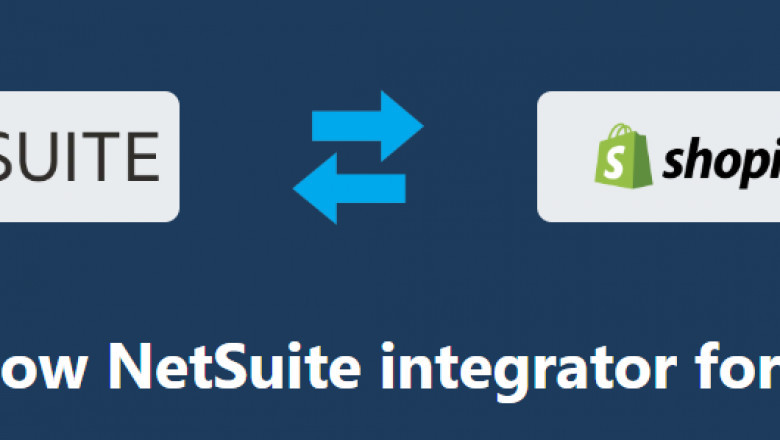views
In 2025, businesses are facing a fast-evolving digital commerce landscape—one where efficiency and accuracy are no longer optional but necessary. If you’re managing an eCommerce store on Shopify while also juggling financials, inventory, and fulfillment in NetSuite, you’ve likely faced one frustrating question: How can I connect these platforms seamlessly without manual work or costly delays? That’s where Shopify integration with NetSuite steps in—and it’s quickly becoming one of the most powerful moves an online business can make.
Whether you're a beginner looking to understand what this integration means, or a scaling business ready to automate backend operations, this guide will break down the essentials of NetSuite connectors and integration platforms and show you how to get started.
What is Shopify Integration with NetSuite?
Shopify integration with NetSuite refers to connecting your Shopify eCommerce store with Oracle NetSuite’s ERP (Enterprise Resource Planning) system. This connection allows automatic synchronization of core business data—such as orders, customer records, inventory, and financials—between the two platforms.
Instead of manually updating inventory counts or copy-pasting order details from Shopify into NetSuite, an integration ensures these processes happen in real-time, reducing human error, boosting operational efficiency, and improving the customer experience.
Integration platforms or "connectors" are the tools that make this possible. These are middleware solutions designed to link Shopify and NetSuite with pre-built workflows or customizable APIs.
Why Is Shopify Integration with NetSuite Gaining Popularity in 2025?
As businesses scale, the need for unified systems becomes more urgent. The rise of multi-channel selling, global shipping, and customer expectations for fast delivery are putting pressure on brands to streamline their backend.
In 2025, there are a few key trends driving the surge in popularity of Shopify-NetSuite integrations:
-
Increased Demand for Automation: Businesses are replacing manual workflows with automated systems to reduce errors and improve order fulfillment.
-
AI-Powered Forecasting: Modern integrations now include AI capabilities that predict inventory needs based on customer behavior and seasonal demand.
-
Omnichannel Fulfillment: Companies selling on Shopify, Amazon, and physical stores need centralized ERP systems like NetSuite to unify operations.
-
Remote and Global Teams: As remote work becomes the norm, having cloud-based integrations ensures teams across time zones work off the same data.
Practical Applications: How Businesses Use Shopify-NetSuite Integration
Thousands of brands have already adopted Shopify integration with NetSuite to solve real-world pain points:
-
Inventory Sync: A fashion retailer uses integration to keep Shopify product stock updated in real-time based on NetSuite warehouse inventory.
-
Order Automation: A beauty brand automatically pushes Shopify orders into NetSuite for picking, packing, and invoicing—no manual data entry.
-
Customer Data Management: A DTC (Direct-to-Consumer) electronics company syncs Shopify customer records into NetSuite to personalize marketing and manage support requests better.
-
Financial Accuracy: A subscription box service syncs financial data to NetSuite for accurate revenue recognition, tax reporting, and forecasting.
These applications not only boost internal efficiency but also help brands deliver better customer experiences—reducing delays, mistakes, and stockouts.
Choosing the Right Connector: NetShopFlow by UANDSolutions
Not all integration platforms are created equal. While there are many connectors available, NetShopFlow—developed by UANDSolutions—has emerged as one of the best apps for Shopify NetSuite integration in 2025.
Here’s why NetShopFlow stands out:
-
Plug-and-Play Setup: Designed for ease of use, even for non-technical users.
-
Real-Time Data Flow: Sync orders, inventory, and customers instantly without delay.
-
Customizable Workflows: Tailor the integration based on your business logic or use pre-configured templates.
-
Scalability: Built for both small startups and enterprise-level Shopify Plus stores.
-
Support and Maintenance: UANDSolutions offers hands-on support and regular updates to keep your integration running smoothly.
Many businesses using NetShopFlow have reported 30–50% reductions in operational workload within months of implementation.
Tips for Getting Started with Shopify NetSuite Integration
If you're ready to take the leap, here are a few starter tips:
-
Assess Your Needs: What data do you need to sync—orders, inventory, customer data, fulfillment info? Map your key processes.
-
Choose the Right Connector: Prioritize platforms like NetShopFlow that are built for flexibility, scalability, and real-time sync.
-
Test Before You Scale: Start with a small batch of products or regions to test the sync behavior before going global.
-
Train Your Team: Ensure your operations, finance, and support teams understand how the systems talk to each other.
-
Monitor & Optimize: Integration isn’t a one-time setup. Monitor sync logs, check for errors, and optimize workflows as your business grows.
Conclusion: Take Your Shopify Store to the Next Level with NetSuite Integration
In today’s digital economy, syncing your front-end eCommerce platform with your back-end ERP is no longer a luxury—it’s a necessity. The Shopify integration with NetSuite allows you to streamline your operations, scale with confidence, and offer customers a frictionless experience from order to delivery.
If you're just starting out, or if your team is bogged down with manual processes, consider exploring trusted solutions like NetShopFlow by UANDSolutions. With the right connector, your Shopify store can run smarter, faster, and more efficiently.














Comments
0 comment